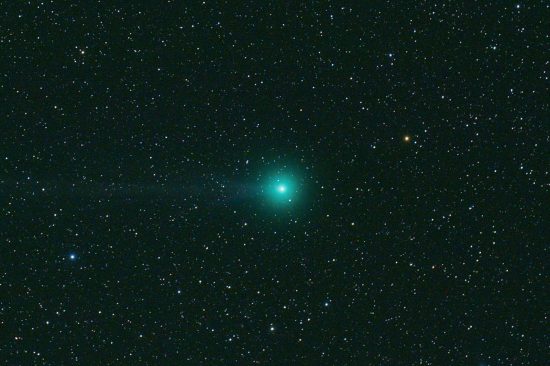
Comets are known as the “dirty snowballs” (also called the snowy dirtballs) of space, icy bodies that contain dust, carbon dioxide, ammonia, methane and and smell like a combination of rotten eggs and horse urine. As comets near the sun, the ice on their surfaces turn to gas to form a cloud know as the coma. The sun’s radiation then helps to form both the comet’s dust and gas ion tail, become visible from Earth as the comet shoots through the Solar System.
Most comets are too faint to to be seen without a telescope; however, some become bright enough to be seen from the Earth without any additional equipment and this month’s Comet Lovejoy is one such comet.
The fifth comet discovered by amateur astronomer Terry Lovejoy, C/2014 Q2 (Comet Lovejoy) is a long-period comet with orbital period of 11, 500 years. However, scientists believe that the gravitational forces exerted by our Solar System’s planets have altered its period so beyond this month, Comet Lovejoy’s next return is expected to be 8,000 years from now.
According to the website earthsky.com, Comet Lovejoy has been getting brighter since its discovery on Aug. 17, 2014. By December 2014, it had brightened to a magnitude of 7.4, thus rendering it visible using a small telescope and binoculars. By mid-December, the comet became visible to the naked eye, and on Jan. 7, 2015, the comet will come closest to the Earth. Amazingly, at this point, the comet will be approximately 43.6 million miles away (70.2 million km), but it will still appear so bright as to be easily seen without instruments.
Already, images have been pouring into various new websites documenting the trajectory of this comet and much has been said about the brilliant, green comet tail that follows in its wake. Currently, scientists estimate that the comet is traveling at 15 miles per second or an astonishing 54,000 miles per hour. Still, this has not prevented amateur astronomers from capturing its flight.
Though Comet Lovejoy is now visible with the naked eye, tonight’s full moon will make observing the comet more difficult. Still, as mentioned above, the comet will be closest to the Earth on Jan. 7 and may then reach a magnitude of 4.1, making it visible from “light-polluted city suburbs.” According to National Geographic News, though the comet has been visible since mid-December, scientists predicted it would not become visible until late January or February 2015. However, the paths of comets can be unpredictable given “chaotic surface activity as they heat up and melt while nearing the sun during orbit.”
The best way to view the comet now is to observe it using binoculars as it travels “through the low southern constellation Columba, the Dove, about 30 degrees south of the constellation Orion.” National Geographic reporter Andrew Fazekas recommends that you wait until late in the night (close to local midnight) for the comet to rise in the southeastern sky, away from the horizon, and then search for it to the right of Sirius, the brightest star in the sky. Good Luck!
(Photo courtesy of Ben)
Comments